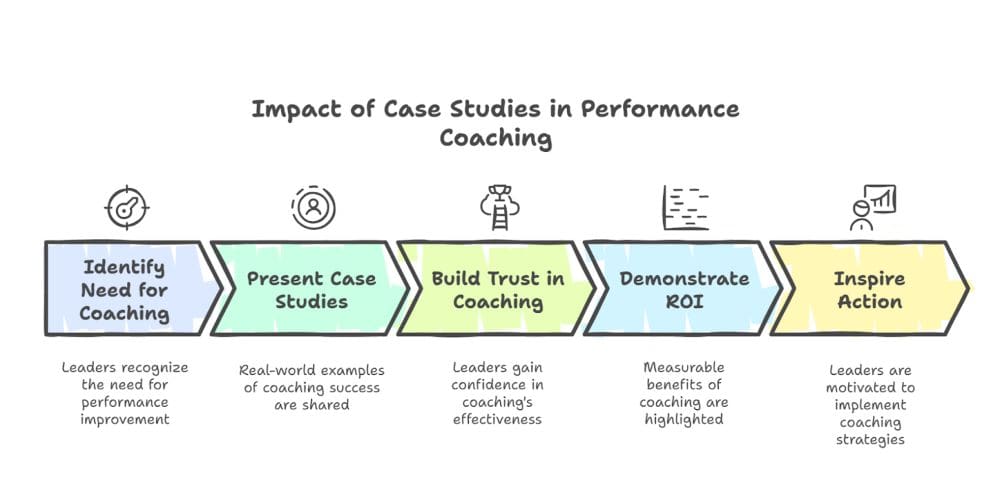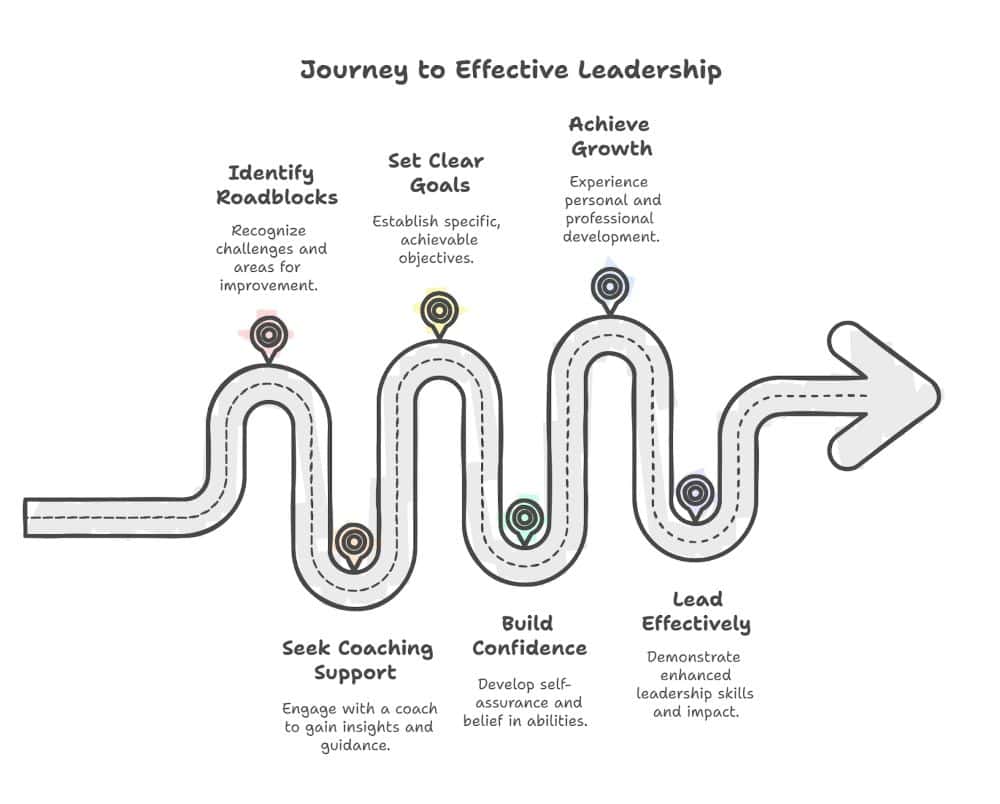
Proven Impact: Case Studies in Performance Coaching for High-Level Professionals
What if one conversation could change how you lead?
That’s the power of performance coaching for professionals—and it’s not just talk.
A study by the International Coaching Federation found that 86% of companies experienced a return on investment from coaching, and 70% of individuals saw improvements in work performance and communication.
Even seasoned leaders hit roadblocks. Some feel overwhelmed. Others question their next move. Coaching helps by creating space to think, set goals, and build confidence.
In this article, you’ll read about real professionals—team leads, executives, consultants—who worked with a coach and got real results. They didn’t just survive challenges; they grew stronger, clearer, and more effective.
Each story shows what’s possible when you get the right support at the right time.
Why Case Studies Matter in Performance Coaching

What makes professionals take action? Tangible results and relatable stories. For leaders considering performance coaching, theory alone is not enough.
They need real examples that demonstrate outcomes—case studies that reveal how other professionals in high-responsibility roles improved their performance, decision-making, and impact through structured coaching support.
These real-world stories help professionals envision the value of coaching in their context.
They are not motivational anecdotes; they are concrete evidence of growth, measured progress, and successful transformation at a senior level.
Proof of Concept for High-Level Decision-Makers
Mid- and senior-level professionals continually evaluate investments in time, people, and resources. Coaching is no exception.
Case studies provide credibility by demonstrating how similar individuals have utilized performance coaching to overcome challenges, enhance clarity, and lead with confidence.
Through detailed case studies, decision-makers gain access to:
- Authentic challenges faced by professionals in demanding roles
- The coaching strategies applied to address those challenges
- Outcomes such as improved team alignment, faster goal execution, or increased leadership presence
When leaders see that others at their level have experienced measurable gains, it builds trust in coaching as a practical, high-value service rather than a generalized development tool.
Evidence of Measurable Return on Investment
Performance coaching is most effective when the results are both observable and quantifiable.
According to research by the International Coaching Federation (ICF), 86 percent of companies that invest in coaching report a positive return on investment.
Additionally, 70 percent of individuals who receive coaching experience improved work performance, better communication, and enhanced productivity.
Well-crafted case studies highlight these types of returns by directly connecting coaching engagements to leadership growth and business outcomes.
Examples include:
- A team leader reducing project delays after developing better delegation skills
- An executive regaining control over competing priorities through goal-focused coaching
- A high-performing consultant achieving promotion after building executive presence.
These stories provide not just validation, but direction. They guide other professionals toward a structured, intentional, and proven process that delivers results.
Case Study 1: Transforming Leadership Under Pressure
Client Background
The client was a senior team leader at a large organization undergoing rapid change.
After a series of internal restructurings, they found themselves managing newly formed teams, each with different expectations, skill sets, and performance histories.
Despite their strong background and leadership skills, the client felt increasingly overwhelmed and disconnected from their usual strategic clarity.
The Challenge
Managing multiple new teams in a short timeframe created a high-stakes environment. Deadlines were being missed, team morale was uneven, and the client’s usual decision-making confidence had diminished.
What had once been a well-managed department had evolved into a reactive and unpredictable work environment.
The pressure to deliver results while navigating interpersonal challenges was beginning to impact both performance and well-being.
Coaching Strategy
The coaching engagement focused on helping the client regain their ability to lead with clarity and purpose. Key areas of work included:
- Stepping back to assess the organizational shifts and how they impacted team dynamics
- Reframing the client’s role from task manager to strategic leader
- Implementing structured delegation processes to reduce overwhelm
- Developing team alignment strategies to ensure consistent deliverables
Each session included targeted exercises and reflection tools to help the client think beyond immediate pressures and reestablish long-term priorities.
Results Achieved
Over several weeks, the client reported a significant shift in both mindset and output.
They regained control over their time, rebuilt communication channels across teams, and refocused their leadership style around strategy rather than task execution.
According to the client:
“She helped me take a few steps back to see the big picture… The new teams are finally producing deliverables effectively, and I no longer feel so overwhelmed.”
— R.M., Lake Forest
The improvements were not just internal. Teams began to operate more independently, and key performance metrics, such as delivery timelines and staff satisfaction, showed measurable improvements.
The client also reported increased confidence when presenting to senior executives, having reestablished their role as a decisive, focused leader.
You’ve hit every milestone, but something still feels off. Fettner Executive and Life Coaching helps high-performing professionals break through plateaus with personalized performance coaching. Schedule a confidential session with us today.
Case Study 2: Executive Rebalancing — Leading Without Burnout
Client Background
This client was a seasoned executive working in a national healthcare organization.
With responsibilities that extended beyond their department to board-level oversight and external partnerships, the client was used to operating at full capacity.
However, mounting responsibilities and personal life challenges began to blur the lines between work and well-being.
The Challenge
Despite their outward success, the client felt internally unbalanced. Their calendar was full, their performance was steady, but personal priorities were slipping.
Relationships were strained, physical health was being neglected, and the ability to stay present at home had diminished.
They didn’t need help managing tasks—they needed help re-aligning their life so that professional success no longer came at a personal cost.
Coaching Strategy
The coaching approach focused on clarity, boundaries, and recalibrating the mindset. Key components included:
- Identifying the client’s core values and how they showed up (or didn’t) in daily decisions
- Clarifying professional versus personal priorities and creating a healthy space between them
- Introducing mindset tools to reduce over-functioning and regain perspective
- Creating an action plan that aligns executive responsibilities with long-term well-being
Rather than viewing balance as time management, coaching focused on redefining success in a way that honored both career and personal life.
Results Achieved
The client reported a dramatic shift in both energy and clarity. They became more intentional with their time, more present in their personal life, and more effective in high-level conversations at work.
Their team also noticed a change—less reactivity, clearer expectations, and more sustainable leadership.
As the client described:
“Working with Marilyn, I was able to clarify my priorities and adopt a new mindset… I feel more in balance.”
— J.P., Hinsdale, IL
In measurable terms, the client reduced evening and weekend work by 40 percent while still meeting key objectives. Stakeholder satisfaction improved, and personal stress levels decreased.
The shift wasn’t temporary—it reflected a permanent redefinition of leadership that included balance as a strategic asset.
Case Study 3: Career Clarity for a High-Achieving Consultant
Client Background
The client was a high-performing professional with over a decade of experience in a consulting role.
Known for delivering results and consistently exceeding expectations, they had advanced quickly, but recently found themselves at a standstill. Despite their success, the path forward had become unclear.
The client felt stuck between continuing with the status quo and making a significant career shift.
The Challenge
Although outwardly successful, the client struggled with internal questions: What is next? Do I want to lead a larger team, specialize further, or transition into a new industry?
The uncertainty was causing hesitation in decision-making and diminishing the client’s usual confidence.
They were seeking guidance not only to evaluate options but also to reconnect with their sense of purpose and direction.
Coaching Strategy
Coaching focused on clarity, self-assessment, and strategic exploration. The approach included:
- Structured exercises to identify personal strengths, values, interests, and areas of disengagement
- Career mapping exercises to evaluate short- and long-term paths
- Development of decision-making frameworks based on both logic and intuition
- Ongoing reflection to test assumptions and uncover hidden opportunities
The process created space for the client to explore professional goals without judgment or pressure.
Results Achieved
Through coaching, the client gained the clarity they were seeking. They identified core values that had shifted over time and realigned their next steps accordingly.
They transitioned from passive career reflection to intentional action, building a targeted plan that included both internal advancement options and carefully selected external opportunities.
As the client shared:
“I was able to gain perspective and clarity with her exercises designed to identify strengths, weaknesses, interests, and values.”
— H.G., Highland Park
As a result, the client felt more in control of their career decisions and was better prepared to advocate for themselves during leadership conversations.
Within months, they had narrowed their focus, initiated key networking conversations, and gained renewed momentum in both confidence and direction.
Lessons from These Performance Coaching Success Stories

Real change happens when strategy meets self-awareness. While each professional in these case studies faced different challenges, such as leadership pressure, burnout, or career uncertainty, they all experienced measurable growth by working with a coach who provided structured support, clarity, and accountability.
Common Coaching Themes Across Success Stories
Despite their unique goals, all three professionals benefited from a few consistent coaching elements:
- Clarity before action: Each client started by stepping back to reassess priorities and gain a broader perspective on their challenges. Whether it was seeing the “big picture” as a leader or re-evaluating career direction, clarity was the foundation for change.
- Personalized strategy: Coaching was never one-size-fits-all. Each engagement was tailored to the client’s role, mindset, and objectives—whether that meant improving team performance, redefining boundaries, or preparing for a transition.
- Leadership mindset shifts: Clients didn’t just learn new tactics; they also developed a new perspective. They learned to think differently. Coaching helped them let go of reactive habits and adopt a more intentional, values-driven leadership approach.
- Structured reflection and accountability: Progress wasn’t left to chance. Coaching sessions included focused exercises, check-ins, and ongoing reflection to turn insights into long-term change.
What These Results Reveal About Coaching at the Professional Level
These outcomes are not coincidences. They reflect what happens when high-performing individuals are given the right framework to evaluate, refine, and elevate their performance.
For professionals at the mid- to senior-level, performance coaching is not about fixing problems—it’s about optimizing potential.
The coaching relationship creates space for clear thinking, strategic adjustments, and sustainable growth, both personally and professionally.
When done right, coaching delivers more than advice. It becomes a strategic tool—used by those who are already successful but know they’re capable of more.
Leading a team but feeling isolated and overwhelmed, and unsure what’s still working? Fettner Executive and Life Coaching provides focused executive and leadership coaching to help you regain control. Contact us to explore next steps.
How to Start Your Performance Coaching Journey
If you’ve ever felt stuck, stretched too thin, or unclear on what comes next, you’re not alone. Even the most accomplished professionals benefit from stepping back and reassessing, with the right support.
Performance coaching for professionals is not about starting over; it’s about taking the next step.
It’s about unlocking what’s already there—refining your strengths, sharpening your strategy, and leading with greater intention.
Know Where You Want to Grow
Start by identifying your current challenge. Are you managing rapid change? Preparing for promotion? Feeling burned out or unmotivated despite success?
The more specific your goals, the more tailored and effective the coaching process becomes.
Choose the Right Coach
Not all coaches are alike. Look for someone who specializes in working with professionals at your level—someone who understands the demands of leadership and can provide practical, honest feedback.
Credentials, industry knowledge, and coaching style all matter.
What Clients Can Expect from Fettner Executive and Life Coaching
Fettner Executive and Life Coaching provides personalized executive coaching for mid- to senior-level professionals seeking more than generic advice.
Every engagement begins with a thoughtful intake process to define your goals, followed by structured, one-on-one sessions tailored to your leadership style and needs.
Whether you’re seeking clarity, confidence, or measurable growth, the approach is grounded in practical strategies and real-world results.
Confidentiality, trust, and professional respect are at the core of every client relationship.
Commit to the Process
Coaching is most effective when it’s consistent. Results come through reflection, practice, and accountability.
As the case studies demonstrate, real progress occurs over time, but it begins with one intentional step.
Conclusion
Performance coaching for professionals is not just a leadership trend—it is a proven tool for achieving measurable, lasting results.
The real-world examples shared in this article demonstrate that coaching can lead to greater clarity, improved team performance, stronger communication, and renewed confidence, even in high-stakes environments.
For mid- and senior-level professionals, the right coaching relationship is not about fixing weaknesses; it’s about developing strengths.
It’s about unlocking untapped potential, refining strategy, and sustaining success in the face of growing complexity.
With the right coach, even high-achievers can continue to grow, both personally and professionally.
Feeling burned out or directionless despite your success? Fettner Executive and Life Coaching offers personal vision coaching to help you reset your path with purpose. Contact us today to get started.
Frequently Asked Questions
What is performance coaching for professionals?
Performance coaching for professionals is a structured, goal-oriented process that helps mid- to senior-level individuals enhance their leadership skills, decision-making abilities, communication, and overall work performance through personalized coaching sessions.
Who benefits most from performance coaching?
Mid-level managers, senior executives, team leaders, and high-performing professionals benefit most. Coaching supports those looking to enhance productivity, transition into leadership roles, or overcome performance challenges.
How is performance coaching different from executive coaching?
While both focus on leadership development, performance coaching often targets specific workplace challenges and outcomes. Executive coaching typically includes broader strategy, vision, and organizational alignment at the C-suite level.
What results can professionals expect from coaching?
Professionals often experience improved clarity, stronger communication, better time management, increased team performance, and faster career advancement. Results vary depending on the goals and the level of coaching consistency.
How long does professional performance coaching take?
Coaching engagements typically last between three and six months, with regular sessions. Some professionals continue long-term for ongoing development and accountability.
Is performance coaching worth the investment?
Yes. According to the International Coaching Federation, 86% of companies report a positive return on investment (ROI), and 70% of individuals experience improvements in work performance, relationships, and goal-setting through coaching.
How do I choose the right performance coach?
Look for a coach with experience working at your professional level, strong credentials, a coaching process that aligns with your goals, and testimonials that demonstrate measurable results.
